How To Use Semrush For Keyword Research: 18 Strategies To Pursue



Disclosure: We only recommend products we use here at Nectafy. Some of the links in this article are affiliate links that may provide Nectafy with a small commission at no cost to you.
“What the heck are we going to write about next on our blog? Anyone have any good ideas?”
That’s a pretty common wall to hit if you’ve just started managing your B2B company’s blog, or if you’re flying without the right instruments.
Today, we’re revealing our B2B content planning process—one that might help you if you’re struggling for blog topics. It’s housed in spreadsheets, based on data, and built using Semrush (an SEO tool)—not a product of whiteboards and brainstorming sessions. It’s what we do every single day for 15 B2B companies and for our own content planning at Nectafy.
We rely heavily on Semrush for our keyword research and content planning. Here we’ll show you the exact procedures we use in Semrush to find great keyword opportunities. (For transparency, we are a Semrush customer and affiliate. If you choose to click through some of the links on this post and sign up, Nectafy may receive a small commission at no cost to you.)
See Also: Semrush Review: 1 Year, Managing 20 Websites
In this post, you’ll learn how to use Semrush for keyword research, including:
- How to use six Semrush tools to find content opportunities
- 18 step-by-step keyword research tactics used on real websites
- 30 blog post ideas generated from those tactics
Try Semrush free for seven days so you can follow along, step-by step.
The sections below are organized by Semrush tools. You can jump to a specific section to find the keyword research tactics associated with each one:
- Topic Research Tool
- Keyword Magic Tool
- Organic Research Tool
- Position Tracking Tool
- Keyword Gap Tool
- Keyword Overview Tool
Let’s dive in.
Semrush Topic Research Tool
Follow along in the Topic Research Tool.
You probably have a good idea of the topics you’d like to rank for at a high level. For example, if you sell payroll processing software, you know you’d love to rank for anything related to “payroll.” The Topic Research tool allows you to plug in one idea (or even your industry name itself) and get back a ton of related topics. All of those will contain hundreds or thousands of keywords for you to pursue.
Keyword Research Tactic #1: Find keywords that fall under topics similar to your brainstormed topics. |
You may refer to your industry as “enterprise data” solutions but some of your potential clients may consider it “data analytics.” Semrush can help you find related topics to your brainstormed ideas. These related topics could be similar ideas just rephrased, or related topics that you hadn’t thought of yet. There is a big opportunity to find keywords in related topics to your ideas.
- Click on the “Topic Research” tab. Search for a topic or keyword idea you have.
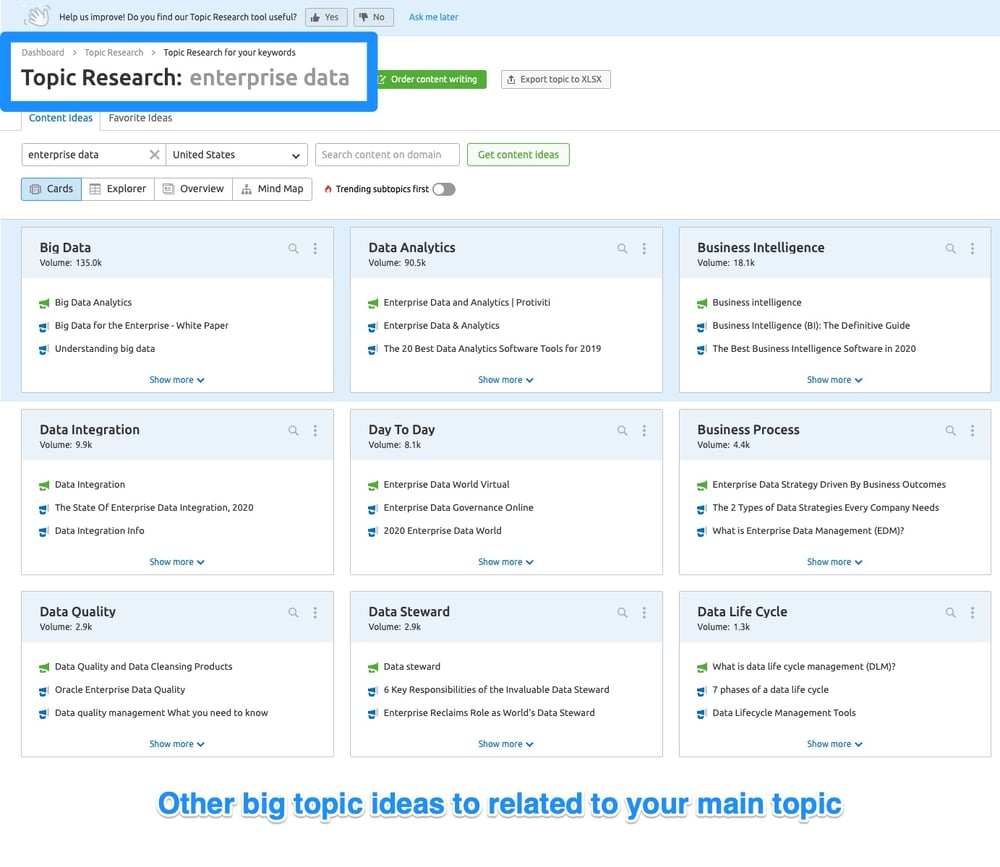
- Then, click on one of the related topics that is relevant to your audience. In the example from above, we clicked on “Data Analytics.” You’ll find a section with headlines that are related to that broad topic:
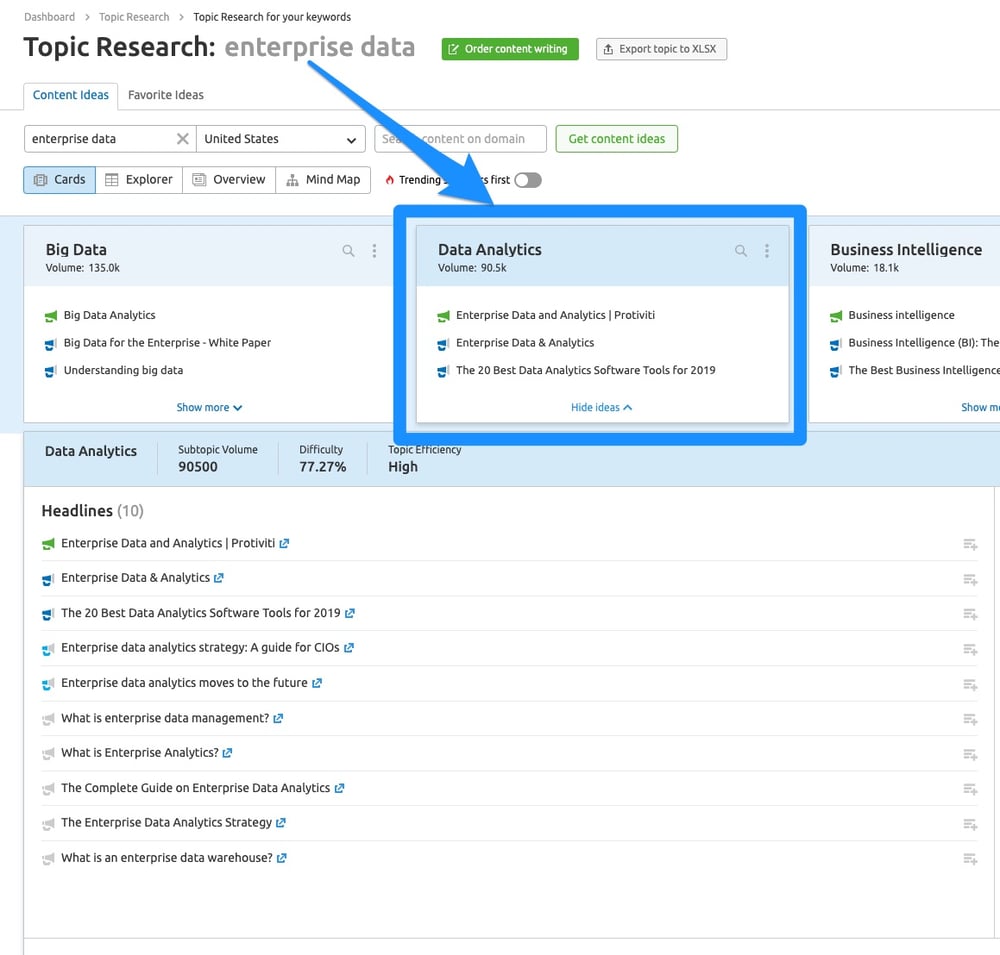
Blog Post Idea: What Will Enterprise Data Analytics Look Like In 2030?
Blog Post Idea: Data Analytics At An Enterprise Level
Blog Post Idea: The Enterprise Data Analytics Strategy & Guidebook
You’ll also find questions that are being asked in Google about the topic.
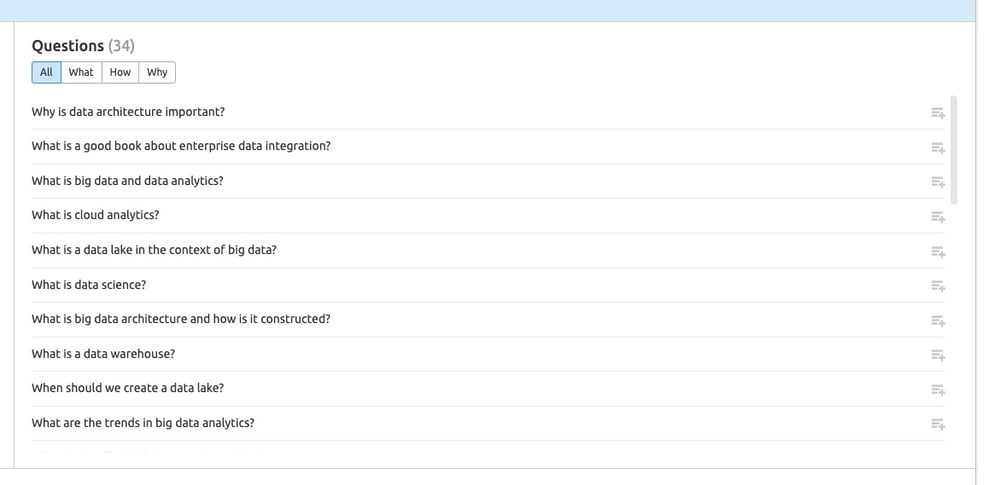
Blog Post Idea Why Is Data Architecture Important?
Blog Post Idea: What Is A Data Warehouse?
Semrush Keyword Magic Tool
Try out the Keyword Magic Tool
The Keyword Magic tool allows you to input your high-level topic (like “payroll”) and see all the keywords available that include or are related to that topic.
Keyword Research Tactic #2: Find keywords that are highly searched and match your important topics. |
If you’ve brainstormed topics that are important to your persona, the Keyword Magic tool allows you to find the keywords related to those topics that are searched with regularity.
- Under the “Keyword Overview” tab, go to “Keyword Magic Tool.” Search for a topic or keyword idea you have. Then, sort the list from highest volume to least. These are the biggest opportunities to tackle from your brainstorm.

Blog Post Idea: 25 Remote Team Building Activities (From 25 Experts)
Blog Post Idea: Managing A Remote Team: A Five-Chapter Guide
Keyword Research Tactic #3: Find keywords that are less difficult to rank for and match your important topics. |
Keywords that are less difficult to rank for and broadly match your important topics
This is the same process as the previous idea. But rather than sorting for keywords with the highest search volume, we are searching for keywords that are least difficult to rank for.
- Under the “Keyword Overview” tab, go to “Keyword Magic Tool.” Search for a topic or keyword idea you have. Then, sort the list from least to most difficult. These are the keywords that, according to Semrush, would be less difficult to rank for. These are likely the best options for you if you’re just starting out with keyword research.

Blog Post Idea: Tools For Remote Teams: The 12 We Rely On Daily
Blog Post Idea: 16 Online Games For Remote Teams, Zoom Parties
Blog Post Idea: Remote Team Activities: 25 Real, Off-The-Wall Ideas
Keyword Research Tactic #4: Find keywords that are related to your important topics. |
This is the same starting point as the previous two ideas. This time, you’re going to look for related keywords rather than matching keywords. This is a way to expand your search beyond the specific ideas you chose to look up.
- Under the “Keyword Overview” tab, go to “Keyword Magic Tool.” Search for a topic or keyword idea you have. Then, switch from “Broad Match” to “Related.”
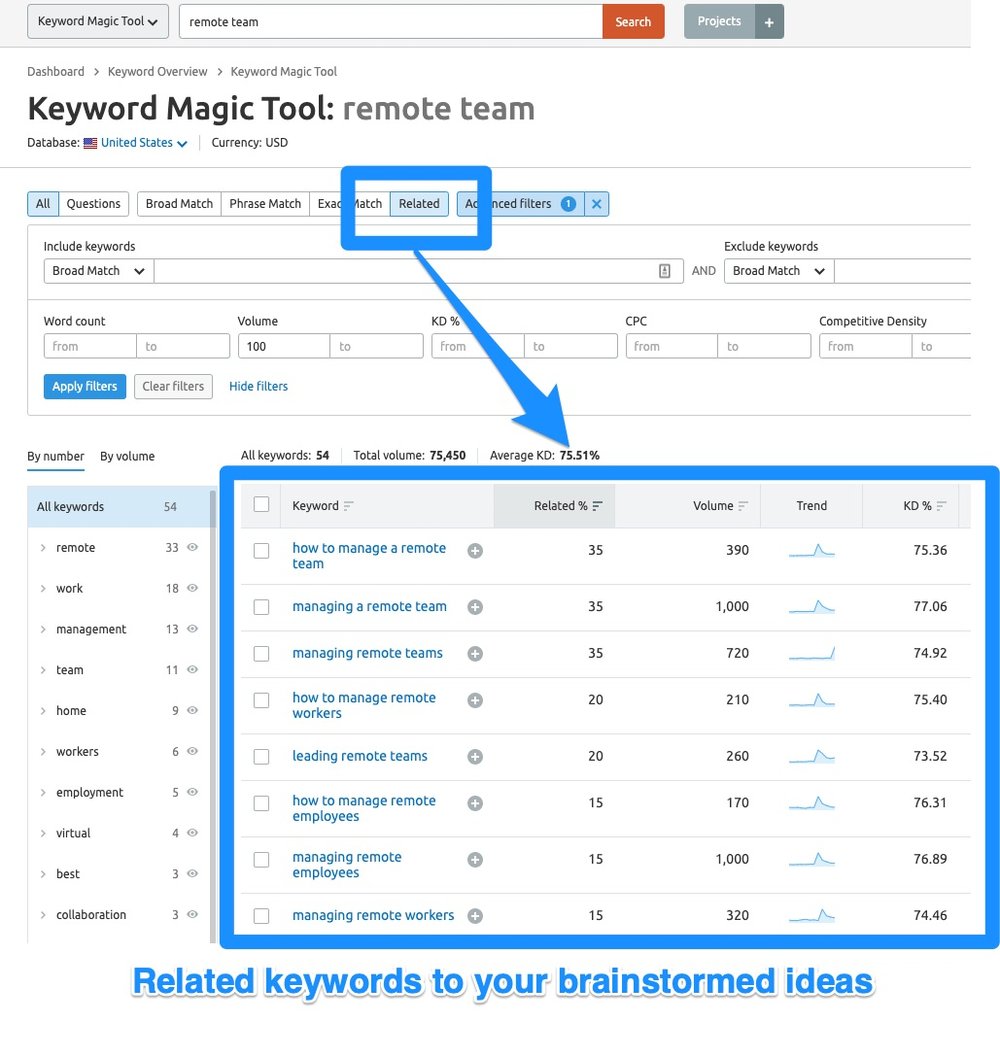
Blog Post Idea: Leading Remote Teams: Advice From 10 Virtual Managers
Keyword Research Tactic #5: Find keywords that are formatted as questions. |
This is the same starting point as the previous idea. This time, you’re going to look for keywords phrased as questions.
- Under the “Keyword Overview” tab, go to “Keyword Magic Tool.” Search for a topic or keyword idea you have. Then, switch from “All” to “Questions.”
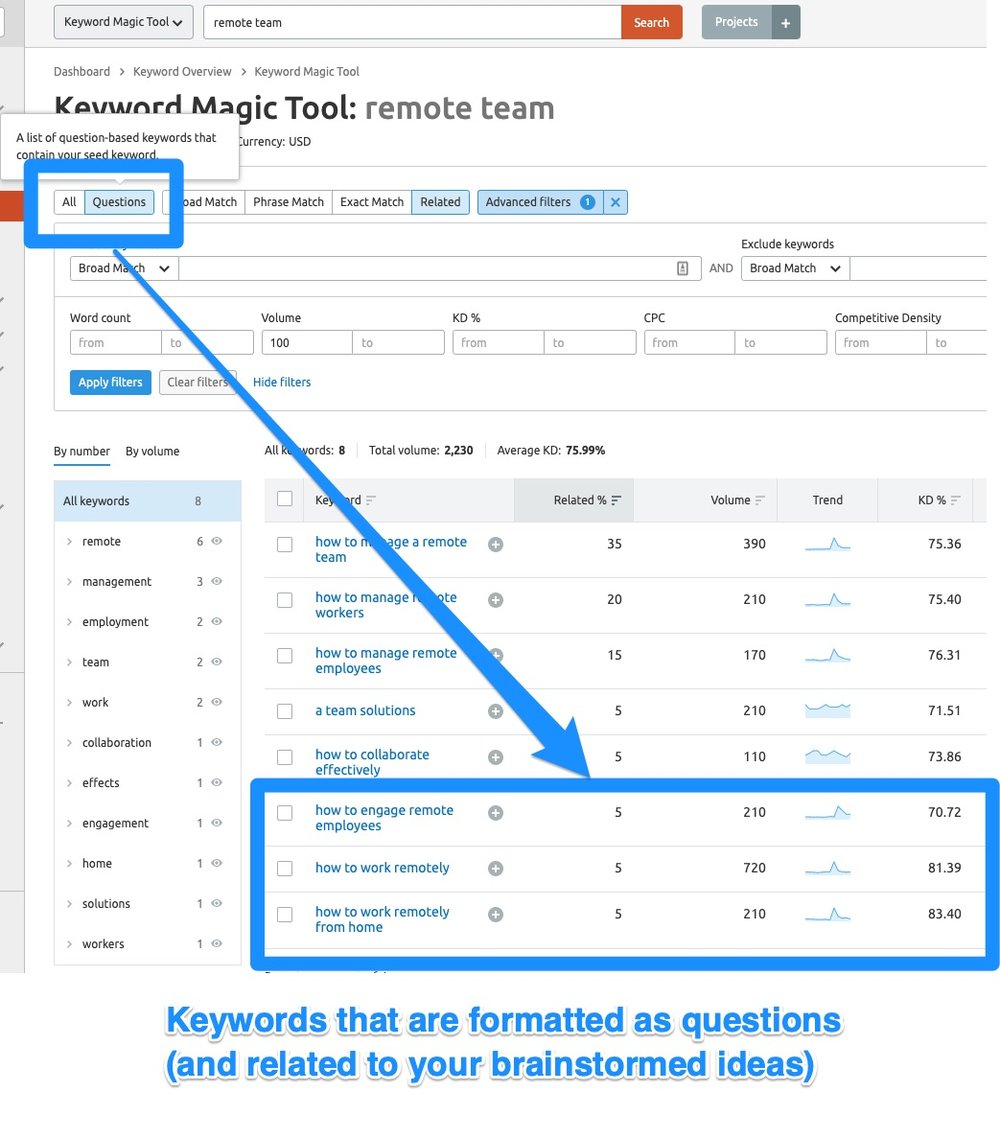
Blog Post Idea: How Can You Engage Remote Employees Effectively?
Blog Post Idea: How To Work Remotely
Semrush Organic Research Tool
Open the Organic Research Tool.
The Organic Research tool allows you to see all of the keywords that a given website is ranking for (whether it’s your own site or a competitor’s). For the next batch of keyword research tactics that take place in the Organic Research tool, we’ll show you some ways to analyze your own website for keyword opportunities.
Keyword Research Tactic #6: Find keywords that recently dropped off page one of Google. |
When blog posts start to get “old” (it usually happens around 18-24 months), they slip in search results. Google wants updated content. Here’s an opportunity to recapture a page-one Google ranking by updating an existing article.
- Under the “Organic Research” tool, you can see every keyword that is ranking for any given website (yours or a competitor’s). You can also see where your keyword rankings are today versus last month.
- Filter by keywords in the top 20 positions in Google. That is all of your page-one and page-two rankings, and you can quickly highlight ones that have slipped off page one (a big, negative impact).
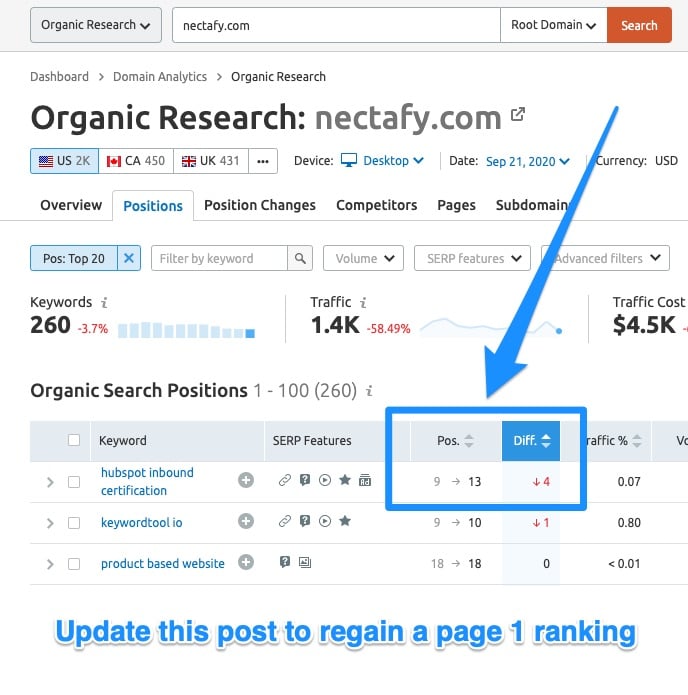
Blog Post Idea: HubSpot’s Inbound Certification: A Thorough Review [2020 UPDATE]
Keyword Research Tactic #7: Find keywords that are close to page one, but need a boost. |
When you are consistently creating good content, a number of keywords will go from unranked (with millions of results in front of them) to somewhere close to page one but not quite there. Go back and revisit these posts. Adding to them may give them a boost to jump onto page one. Here’s an opportunity to find keywords that are stuck on page two through five of Google, but could be boosted to page one.
- Filter by keywords in positions 11-50 in Google—essentially all your keywords on page two through five of Google results. These are your best opportunities possible! They aren’t doing anything for you right now, but they are really close to bringing in more visitors and leads.
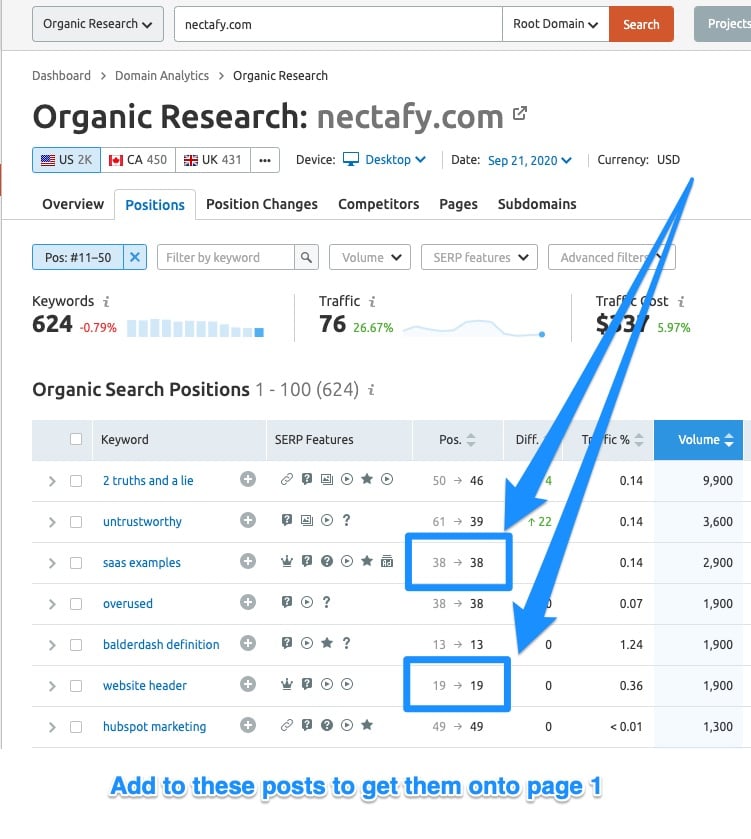
Blog Post Idea: 40 Examples Of SaaS Website Design Done Right
Blog Post Idea: The Website Header Guide: Ten Essential Elements To Include
Keyword Research Tactic #8: Find keywords that are on page one, but not in the top three results. |
The top three results in Google gobble up most of the clicks. According to Brian Dean of Backlinko…
- The #1 result in Google gets 31.7% of all clicks.
- The #2 result gets 24.7%.
- The #3 result gets 18.7%.
That means a whopping 75% of clicks come from the top three Google results, which is why moving an existing ranking from position four to position two would almost certainly bring better results than creating a new piece targeting a new keyword. Here’s an opportunity to to push keywords higher up on page one.
- Filter by keywords in positions 4-10 positions in Google. That is all of your keywords on page one, but not in the money spots (1-3). These keywords may already be some of your top performers, but they could be even better.
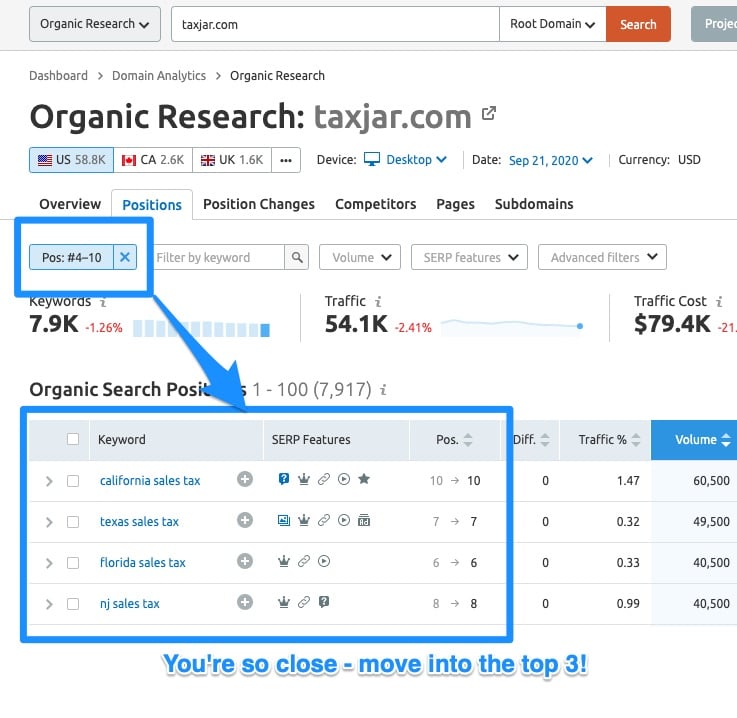
Blog Post Idea: Florida Sales Tax Guide For Businesses [2020 UPDATE]
- This post exists already for this website. An addition and update could move it up a few positions.
- Another idea is to try guest posts on related websites that link back to this one (to boost the article’s authority).
Keyword Research Tactic #9: Find keywords that were higher up on page one, but have slipped. |
This is the inverse of the previous idea. In some cases, your keywords were in the top three (or at least higher up on page one of Google) but have slipped back for any number of reasons. This is your chance to reclaim your previous high rankings. Here’s an opportunity to fix page-one keywords that have slipped.
- Go to the “Position Changes” tab and filter by “Declined and Lost.” Then, sort the position from lowest to highest. This will surface your keywords that were once high up on page one of Google but have recently declined.
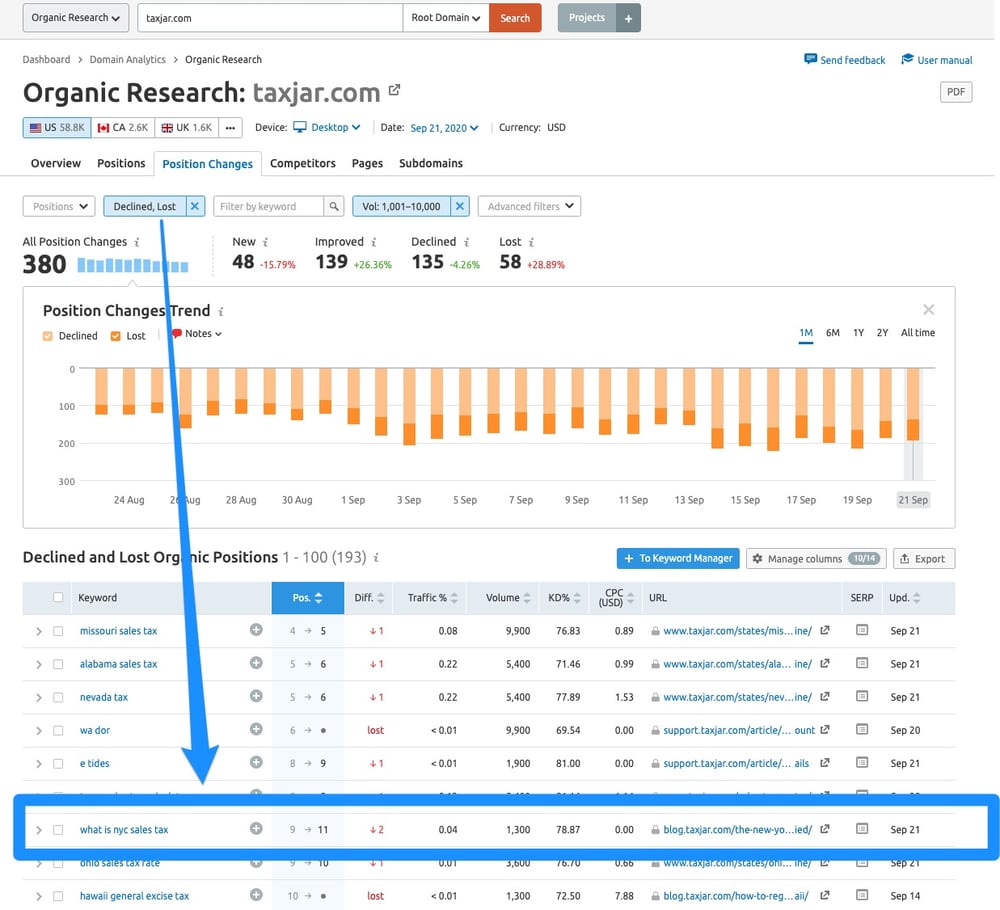
Blog Post Idea: What Is The New York City (NYC) Sales Tax?
- A blog post called “The New York Clothing Sales Tax Exemption Defined” is currently ranking for this keyword. It’s not a great match for the keyword.
- Add a link from that blog post to the new one to pass some of the authority through.
Keyword Research Tactic #10: Find topics in which your site is quickly gaining in authority. |
Google’s algorithm trusts that if you are a good source of information for, say, “content marketing tips” then you’ll likely be a good source for information about “content marketing plan,” “content marketing examples” and “content marketing statistics.” Therefore if you are gaining in authority for new keywords, you could likely be gaining just as quickly for related keywords. The entire topic could be an opportunity for you. Here’s how to find topics in which your authority is growing and discover new keyword opportunities within those topics.
- Go to the “Position Changes” tab and filter by “New and Improved.” Then, sort from the biggest difference to the smallest. This will put keyword rankings that are quickly increasing at the top.
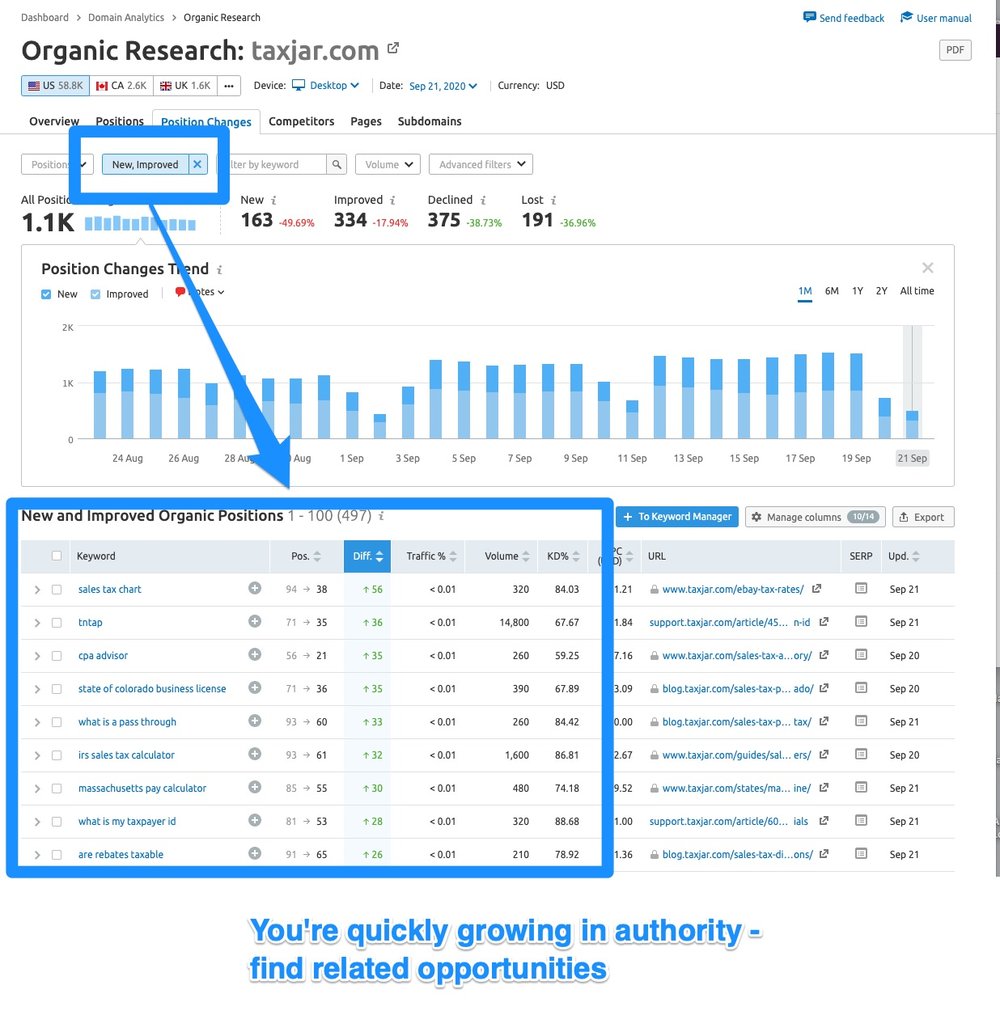
- Then, click on one keyword that could be a good opportunity to grow. This will pull up the “Keyword Magic Tool” for your chosen keyword. (In the example above, it’s “sales tax chart.”)
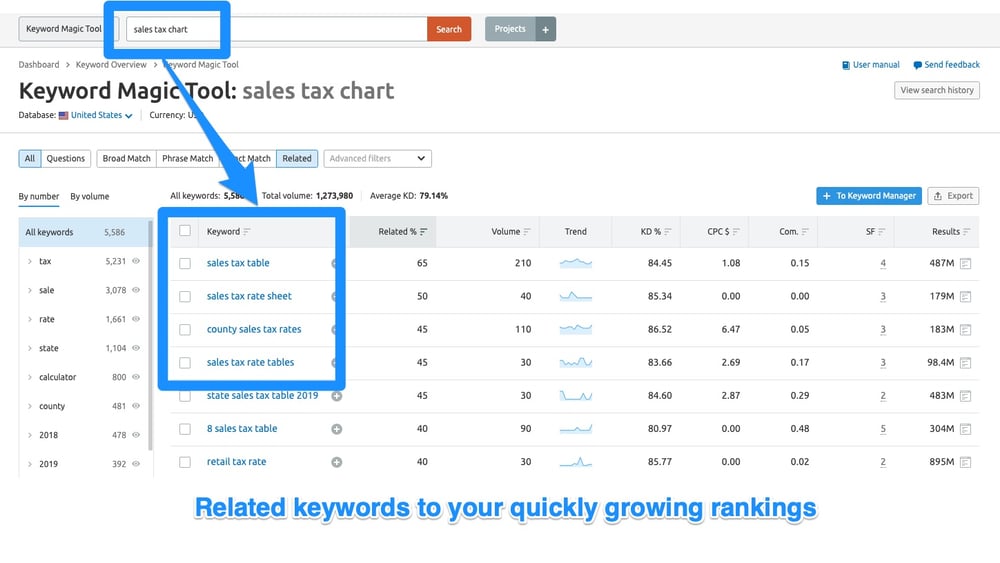
Blog Post Idea: The 2020 Sales Tax Table For Every State
Blog Post Series Idea:
- The 2020 County Sales Tax Rates For California
- The 2020 County Sales Tax Rates For New York
- The 2020 County Sales Tax Rates For Florida (etc.)
Keyword Research Tactic #11: Find high-ranking keywords that could be featured snippets. |
A “featured snippet” is a search result feature in Google that attempts to answer a simple question with a few sentences, a call-out box, and a link to where the description was pulled from. Here’s a featured snippet explaining featured snippets:
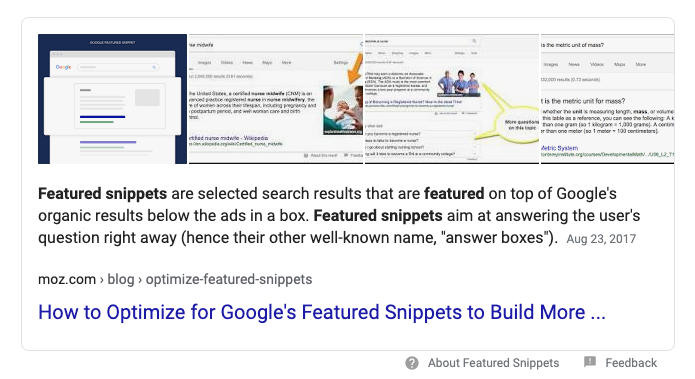
Whenever you rank near the top of page one, there’s a chance your site could be pulled into this featured box. That’s good real estate. Here’s an opportunity to get a featured snippet ranking by optimizing an existing blog post.
- Sort the “On SERP” (Search Engine Results Page) for featured snippets. That’ll filter for the keywords that typically have featured snippets show up in search results. Not all searches do.
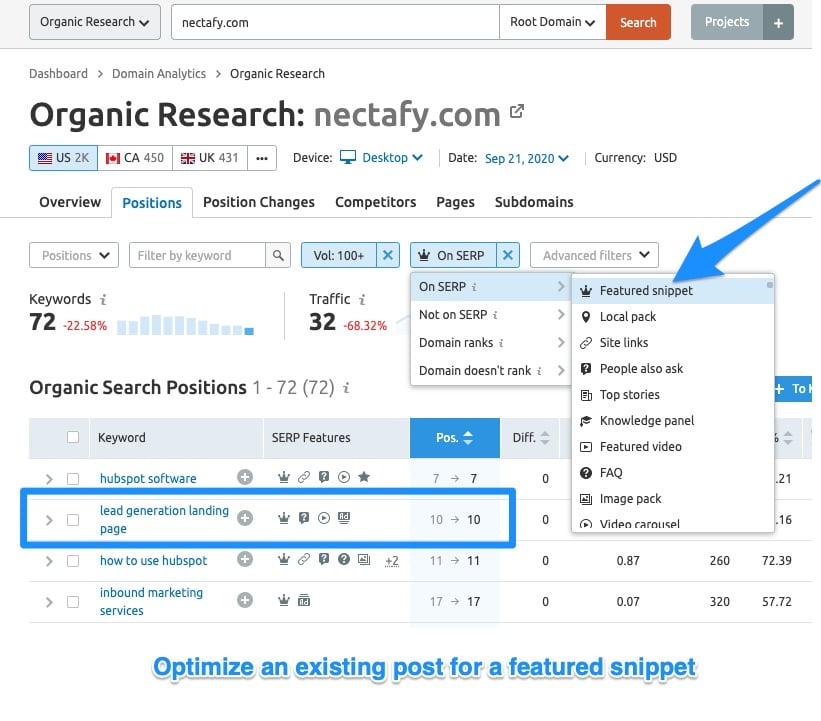
Blog Post Idea: 30 B2B Lead Generation Landing Page Examples
- Add a 40-60 word definition of a “lead generation landing page” at the top of the article under a header with that keyword in it.
Keyword Research Tactic #12: Find high-ranking keywords that could also rank as a video. |
A “video carousel” is a search result feature in Google that allows you to flip through relevant videos on the topic. Not all keywords get a video carousel, which means that Google is doing some work to match search intent with media type.
Here’s an opportunity to get a keyword to rank in multiple ways: with a video ranking alongside your existing blog ranking.
- Sort the “On SERP” (Search Engine Results Page) for video carousel. That’ll filter for the keywords that typically have video carousels show up in search results.
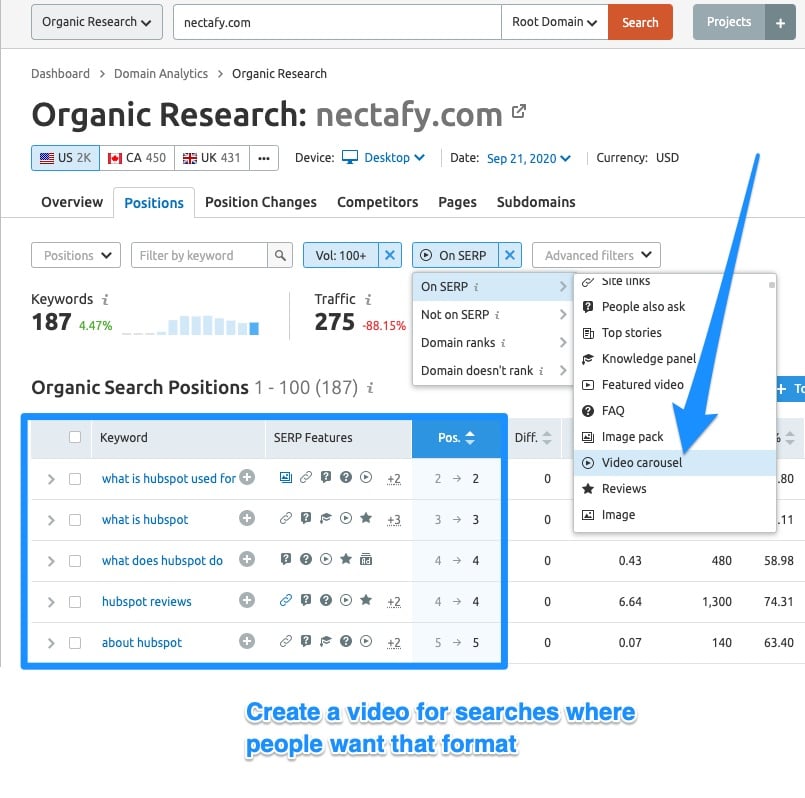
Video Blog Post Idea: What Is HubSpot (& What Do We Use It For)?
- Create this video and add it to your existing article that ranks for the topic. Be sure to post it to YouTube (since Google owns YouTube, I’m sure they prefer YouTube videos over all others).
Keyword Research Tactic #13: Find keywords that are related to your existing keyword rankings (double down on your strengths). |
If you rank at the top of page one for a keyword, you are more likely to also rank for keywords that are closely related to that keyword. This is a big opportunity to increase your visits and leads with a high-likelihood of success. Here’s an opportunity to get more rankings through related keywords.
- Search your existing rankings in the organic research tool. Look for top-five positions with good search volume (1,300 in our case for “HubSpot review” below).
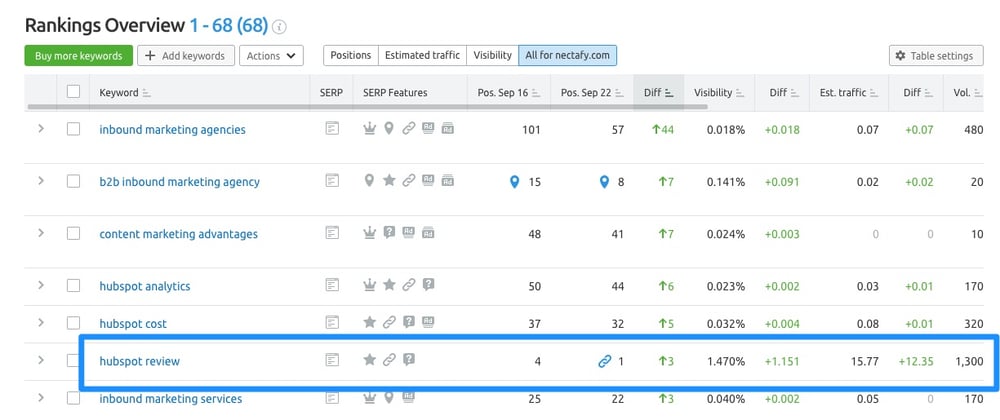
- Then, search in the same tool for a broader term to hone in on the opportunities. Since we rank highly for “HubSpot review,” I searched for “HubSpot” in Semrush to broaden the net.
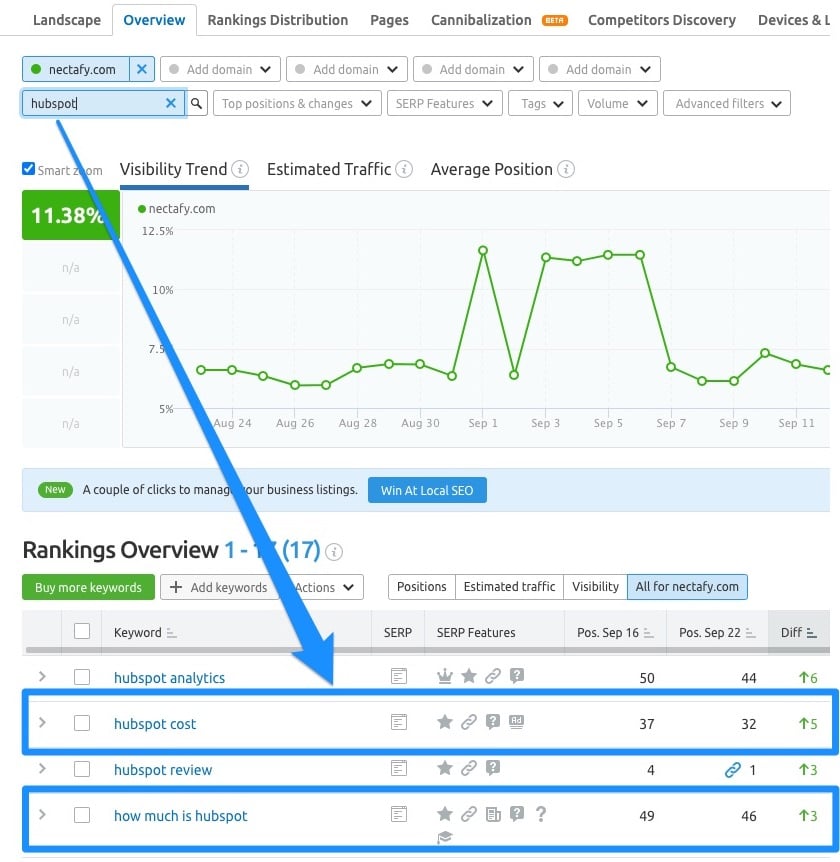
Blog Post Idea: HubSpot Costs: A Breakdown Of How Much It Will Run You
Semrush Position Tracking Tool
Follow along in the Position Tracking Tool.
The Organic Research tool in Semrush analyzes an entire website at once and displays all keyword rankings in the top 100 results of Google. Position Tracking, on the other hand, shows your keywords you choose to follow closely. These are your most important keywords, tracked throughout time to show trends.
Keyword Research Tactic #14: Find declining keyword rankings that could be fixed. |
In tactic #6 above, we talked about how to surface declining keywords in the Organic Research tool. Those opportunities are ones that you may or may not be aware of, but could bring back lost traffic. When declining rankings appear in your Position Tracking tool, it means one of your chosen keywords to track is dropping. These you should get on right away. Here’s an opportunity to fix declining rankings on your top keywords.
- In the Position Tracking tool, sort by the “difference” column to show the biggest drops at the top of the list. If you find one that has dropped, expand to the time frame to see how the keyword has performed over time. If it’s been significantly down for a while, it’s time for a rewrite to regain the ranking and visits.
![]()
Blog Post Idea: 10 Inbound Marketing Agencies I Wish Weren’t So Darn Amazing
Keyword Research Tactic #15: Search for your important keywords that competitors outrank you on. |
Position Tracking contains your most important keywords to watch. If your competitors were ranking higher than you on your own hand-selected keywords, you’d want to know, right? Here’s an opportunity to close the gap on some of your competitors.
- In the Position Tracking tool, add a competitor’s name in the box next to yours. This will pull in your site’s visibility on your tracked keywords compared to that competitor.
![]()
Blog Post Idea: An Extensive HubSpot CRM Review [UPDATED: 2020]
Keyword Research Tactic #16: Find important keywords that could become featured snippets. |
Above, we highlighted how to find featured snippets in the Organic Research tool. You can find more specific opportunities in the Position Tracking tool as well.
Here’s an opportunity to get a featured snippet for a high-value keyword.
- In Position Tracking, go to “Featured Snippets.” You’ll see a list of specific featured snippet opportunities that you don’t currently rank for.
![]()
Blog Post Idea: The Proven Content Marketing Strategy For B2B
- Add a 40-50 word definition of a “content marketing strategy” at the top of the article under a header with that keyword in it.
Semrush Keyword Gap Tool
Try out the Keyword Gap Tool to follow along.
The Keyword Gap tool allows you to compare multiple website domains at once. For example, you could choose to compare your website versus your top competitor’s site. Then, you can sort the findings in a number of ways to see where you are beating your competitor and vice versa in search results.
Keyword Research Tactic #17: Search for keywords that you aren’t tracking, but your competitors outrank you on. |
In the Organic Research tool section, we talked about keywords that your competitors were outranking you on that you are specifically tracking. In the Keyword Gap tool, you can compare every keyword ranking across multiple websites. Here’s an opportunity to find new keyword ideas by analyzing your competitors’ sites against yours.
- Under Domain Analytics, go to “Keyword Gap.” Enter a competitor’s website next to yours under “Root Domain.” Then, sort your competitor’s rankings from smallest to largest (highest ranking to lowest). This will show all your competitor’s top rankings and where you rank on those right next to it.
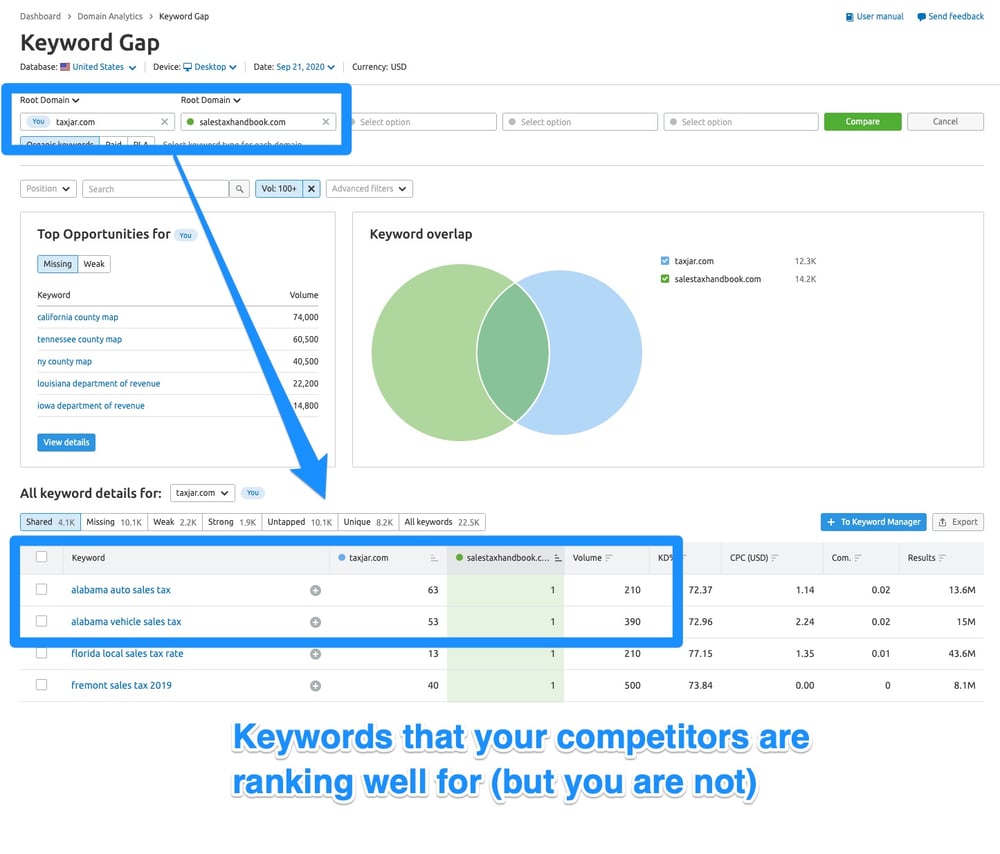
Blog Post Idea: A Guide To Alabama’s Auto Vehicle Sales Tax
Semrush Keyword Overview Tool
Follow along in the Keyword Overview Tool.
The Keyword Overview tool gives you a chance to analyze a given keyword for a number of metrics: search volume, keyword difficulty, trends in search volume, keyword variations, and more.
Keyword Research Tactic #18: Search for supporting keywords on pages that rank highly for your industry’s main keywords. |
The Keyword Overview tool also shows you key metrics for the website pages that are already ranking for the keyword: page authority score, backlinks, estimated traffic, and the keywords that are ranking on that page. This allows you to make an educated guess as to why certain sites are ranking at the top of results pages, so you can see what it would take to beat those sites.
Here’s an opportunity to analyze pages that rank highly for your industry’s main keywords, so you can find supporting keywords to pursue.
- Under the “Keyword Analytics” tool, click on “Overview.” Search for an important keyword, then look at the “SERP Analysis” section.
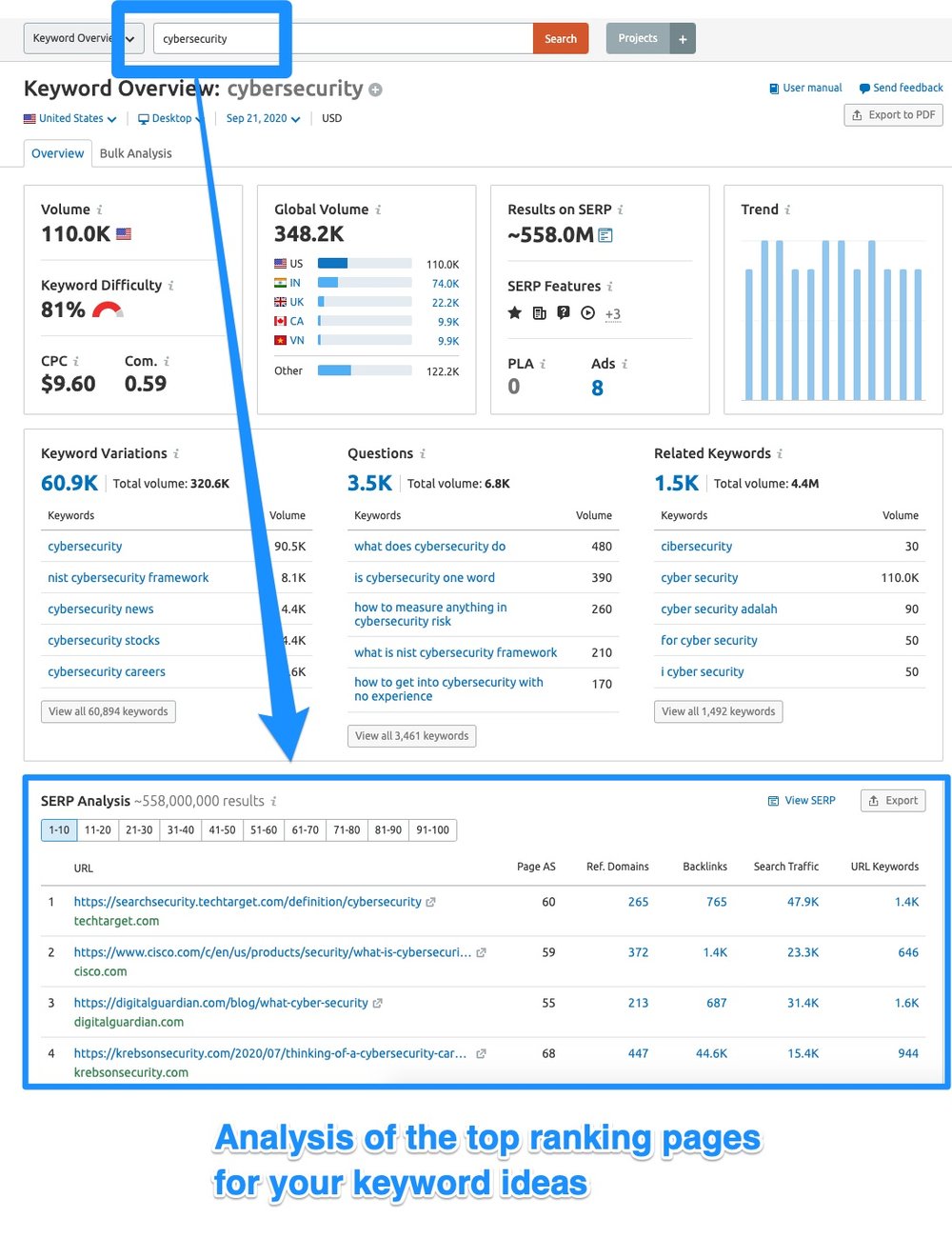
- Then, click on each link in the “SERP Analysis” section. This will pull up all the keywords the page is ranking for. These can be supporting keywords to target if you choose to go after the big keyword or longer-tail keywords for other articles.
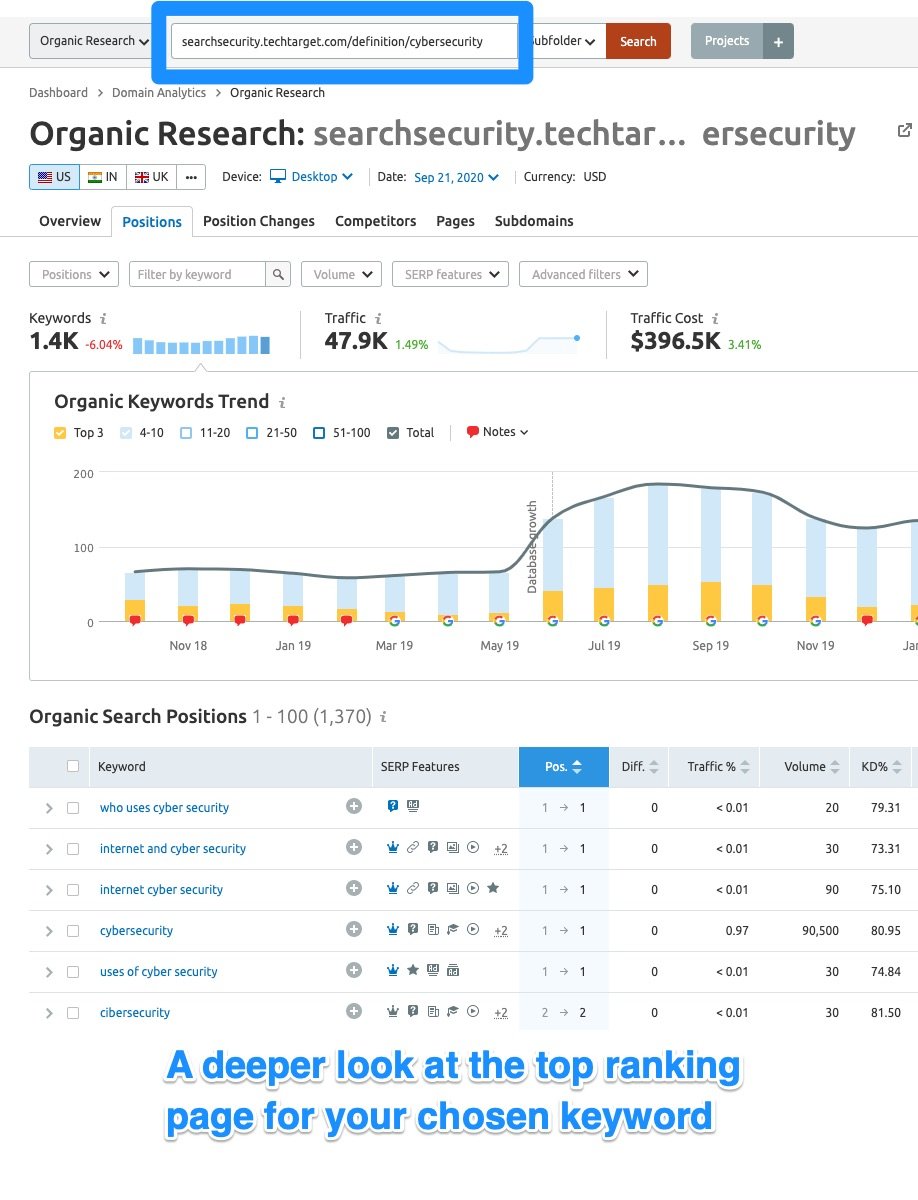
Blog Post Idea: Who Uses Cyber Security? A Guide For Small Businesses
Where to take your keyword research process from here.
That was a lot to digest.
But since each individual tactic can be used on its own, I recommend just picking one of the 18 techniques from this article to find ideas for your next B2B blog post. That ought to simplify things. Once you’ve decided on a tactic to try out, you have a few ways to go.
As you can see, we’ve built all these tactics to specifically fit in Semrush, the keyword research tool we use. When you’re ready to do content planning, sign up for a free seven-day trial. See how much value you can squeeze out of this post and one week in Semrush.
- Do keyword research in other tools.
Just because we listed all of the steps in Semrush doesn’t mean you have to do your research there. We’ve used a lot of other tools in the past and others that are still part of our process today: 1) Keywordtool.io; 2) a combination of Google Keyword Planner and Search Console, HubSpot, and spreadsheets; 3) Ahrefs; and 4) Ubersuggest.
See if you can replicate the tactics you just read about in your SEO tool of choice.
- Do keyword research with a little help from Nectafy.
If this all looks a little far afield for your content planning, let’s talk. This is what we do for B2B clients on a daily basis to help grow leads organically. We’d be happy to discuss your goals as a business and how growth content could fit into the plan.

